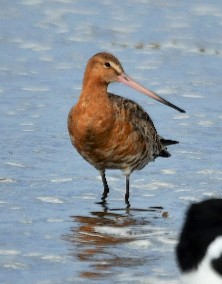July 2023
Bird Sightings



July was wet. In comparison to June, July was wetter and cooler with fifty percent more rain. In comparison to last July, this July had five times as much rain. The impact on the breeding success of most our visiting summer birds, particularly those that relied on airborne insects to feed young was mixed. Looking at the proportion of adult to young birds from information gathered by licensed bird ringers, Willow Warbler, had a good breeding season whereas Whitethroat had a poor breeding season. Similarly, while Sand Martin did not seem to return in as big a number as previous years and House Martin were later arriving in numbers, these species and Swallow had a good season although this was not uniform across the island. As reported in the June notes, garden birds seemed generally to be thriving. Among our resident species Bullfinch, Goldcrest, House Sparrow, Lesser Redpoll and Wren had a very good breeding season.
Other signs of a successful breeding season included: a pair of Mute Swan with seven young in Machrie Bay on 11th, a juvenile Great Spotted Woodpecker in Shannochie on 12th, juvenile Reed Bunting and juvenile Stonechat in Glen Rosa on 14th, a pair of Shelduck with nine flying young in Port na Feannaiche on 25th, an Eider creche with around ten young in Margnaheglish also on 28th, a family of Spotted Flycatcher in Brodick Country Park also on 28th and a family of Whinchat in Glen Iorsa also on 28th. Golden Eagle, Hen Harrier, Peregrine and Kestrel were all reported with young.
On the downside there is an ongoing concern about disturbance on shores of nesting Oystercatcher and nesting Ringed Plover by dog walkers. In addition, diminishing records of breeding Curlew, Fulmar and Lapwing is a continuing cause for concern.
July marks the end of the breeding season for some birds. It can be an interesting time looking for breeding species dispersing from their breeding grounds, many still in their breeding plumage. Reports included; a Whimbrel on Sliddery Shore on 7th, five Black-headed Gull and a Merlin also on Sliddery Shore on 12th, three Greenshank on Cleats Shore on 19th, four Golden Plover in Catacol Bay on 21st, seventeen Turnstone and twenty-one Dunlin in Blackwaterfoot on 23rd, a Kingfisher in Mossend Pond on 26th and a Black-tailed Godwit at Cordon on 27th.
In addition, after breeding many species begin to flock together. Reports included; one hundred and fourteen Jackdaw at Sliddery on 11th, fifteen Oystercatcher at Porta Buidhe on 15th, sixty Shag also at Porta Buidhe on 18th, one hundred Linnet on Cleats Shore on 19th, seventy Lesser Redpoll in Corriecravie on 21st, twelve Red-breasted merganser at Dougarie on 22nd, one hundred and twenty Herring Gull in Kildonan on 25th, four hundred Starling in Sliddery also on 25th and one hundred and twenty Manx Shearwater off Rinn a' Chrubain on 28th.
Last July, Highly Pathogenic Avian Influenza ( HPAI) H5N1 arrived on Arran. By the end of the month over 350 dead birds had been recorded. This July there were no confirmed cases on Arran in either wild or captive birds but in the UK, H5N1 is still prevalent and the body of a Common Tern on shore at Sannox on 26th, last recorded on Arran ten years ago, was suspected to be a result of avian flu. ( More in Arran Banner of 28 July 2023 page 5 )
Over a hundred species were reported in July. Other highlights included; two Red Grouse in Glen Sannox on 3rd, one Magpie Kingscross on 7th, fourteen Swift over West Mayish on 8th, one Rook Corriecravie on 21st, thirty-five Gannet off Rinn a' Chrubain on 28th, a Water Rail by Corriecravie on 28th and the over-summering Whooper Swan at Clauchlands on 31st. Finally, the last date that I have for Cuckoo is 28th when one juvenile was reported on Corriecravie Moor.


